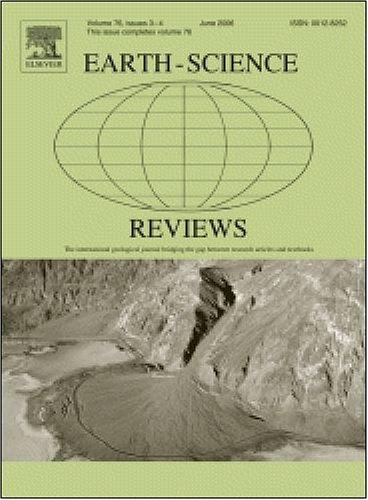Wind erosion in northern China: Insights from the western Qaidam fold belt, Loess Plateau, and Hami Basin
IF 10.8
1区 地球科学
Q1 GEOSCIENCES, MULTIDISCIPLINARY
引用次数: 0
Abstract
Pliocene – Quaternary wind erosion profoundly modified the physiography of northern China at a large range of spatial (10 m to >100 km) and temporal (10 ka to Myr) scales. In the western Qaidam Basin along the northeastern margin of the Tibetan Plateau, northwesterly winds sculpted yardangs in actively folding Miocene – Pleistocene strata. Wind erosion was most dominant during glacial periods, whereas lacustrine deposition was more extensive during warmer and wetter interglacial periods. Cyclical wind erosion and sedimentation is recorded by paleoyardangs in Pliocene – Pleistocene strata. A thickness of hundreds to thousands of meters of strata has been blown off the crests of Qaidam anticlines. Wind erosion initiated at ∼3 Ma and increased in spatial extent and magnitude from early to late Pleistocene time as aridity intensified and strata were tectonically uplifted. Qaidam anticlines are propagating in the windward direction and accelerated in growth concomitant with wind erosion, raising the possibility that spatially variable removal of mass by wind influenced the rates and kinematics of deformation. To the east of Qaidam Basin is the Chinese Loess Plateau. The northern, windward margin of the central Loess Plateau is an up to 400-m-high erosional escarpment made of loess that slopes northward into the wind-eroded and endorheic Mu Us Desert. During Pleistocene aridification and expansion of the Mu Us Desert, the Loess Plateau escarpment margin retreated as it was wind eroded while loess continued to accumulate downwind and further build the plateau. The Hami Basin within the eastern Tian Shan of northwestern China is one of the windiest regions on Earth today and part of the broader Gobi Desert that extends eastward into Mongolia. In the north-central Hami Basin, northerly winds sculpted yardangs in Cretaceous strata and have blown a thickness of ≥200 m of Cretaceous – Pleistocene strata out of the closed basin. Wind erosion of northern Hami Pleistocene alluvial deposits led to the widespread development of unconsolidated gravel deposits and pavements. These gravels armor underlying alluvial strata from further wind erosion and thereby suppress dust emissions, despite extreme winds. The Hami and other Gobi Desert basins may have experienced an overall decrease in dust emissions from Pliocene to late Pleistocene time as the volume of silt-bearing strata decreased in the basins while the area of the basins armored by gravel increased. Structural unloading joints in some Hami yardang fields accelerate rates of wind erosion and yardang demise, and their wind-parallel orientation provides another potential example of an interplay between wind erosion and rock deformation. This review suggests that the sources and fluxes of Asian dust were not spatially uniform through the Neogene and Quaternary. The geological and topographic history, landscape evolution, and short- and long-term climate variations in Asia all need to be simultaneously evaluated when interpreting terrestrial and marine archives of dust in the context of past and future climate changes.
中国北方风蚀:来自柴达木西部褶皱带、黄土高原和哈密盆地的启示
上新世—第四纪风蚀在大空间尺度(10 m ~ 100 km)和时间尺度(10 ka ~ 1000年)上深刻地改变了中国北方的地貌。在青藏高原东北缘柴达木盆地西部,西北风在中新世—更新世活跃的褶皱地层中塑造了yardangars。冰期以风蚀为主,间冰期以湖相沉积为主。在上新世-更新世地层中,古雅堂记录了周期性风蚀和沉积。柴达木背斜的峰顶被吹出了数百至数千米厚的地层。风蚀开始于~ 3 Ma,随着干旱加剧和地层构造隆升,从早更新世到晚更新世,风蚀的空间范围和强度增加。柴达木背斜在迎风方向上扩展,并伴随着风蚀加速生长,这增加了风对质量的空间变化影响变形速率和运动学的可能性。柴达木盆地以东是中国黄土高原。黄土高原中部北部的迎风边缘是一个高达400米高的侵蚀性悬崖,由黄土组成,向北倾斜,进入被风侵蚀的内陆性毛乌素沙漠。在更新世毛乌素沙漠干旱化扩张过程中,黄土高原陡坡边缘因风蚀而退缩,而黄土继续在下风积聚,进一步形成高原。位于中国西北部天山东部的哈密盆地是当今地球上风最大的地区之一,也是向东延伸至蒙古的更广阔的戈壁沙漠的一部分。在哈密盆地中北部,北风在白垩系地层中塑造了yardangs,并将厚度≥200 m的白垩系—更新世地层吹出封闭盆地。哈密北部更新世冲积层的风蚀作用导致松散砾石层和路面广泛发育。这些砾石使冲积层免受进一步的风蚀,从而抑制了灰尘的排放,尽管有极端的风。从上新世到晚更新世,哈密等戈壁盆地的含粉地层体积减少,而砾石包皮的盆地面积增加,总体上减少了沙尘排放。哈密坝田的一些构造卸荷节理加速了风蚀和坝田消亡的速度,它们的风平行方向为风蚀和岩石变形之间的相互作用提供了另一个潜在的例子。研究表明,新近纪和第四纪亚洲沙尘的来源和通量在空间上并不均匀。在过去和未来气候变化的背景下解释陆地和海洋沙尘档案时,需要同时评估亚洲的地质和地形历史、景观演变以及短期和长期气候变化。
本文章由计算机程序翻译,如有差异,请以英文原文为准。
求助全文
约1分钟内获得全文
求助全文
来源期刊

Earth-Science Reviews
地学-地球科学综合
CiteScore
21.70
自引率
5.80%
发文量
294
审稿时长
15.1 weeks
期刊介绍:
Covering a much wider field than the usual specialist journals, Earth Science Reviews publishes review articles dealing with all aspects of Earth Sciences, and is an important vehicle for allowing readers to see their particular interest related to the Earth Sciences as a whole.
 求助内容:
求助内容: 应助结果提醒方式:
应助结果提醒方式:


